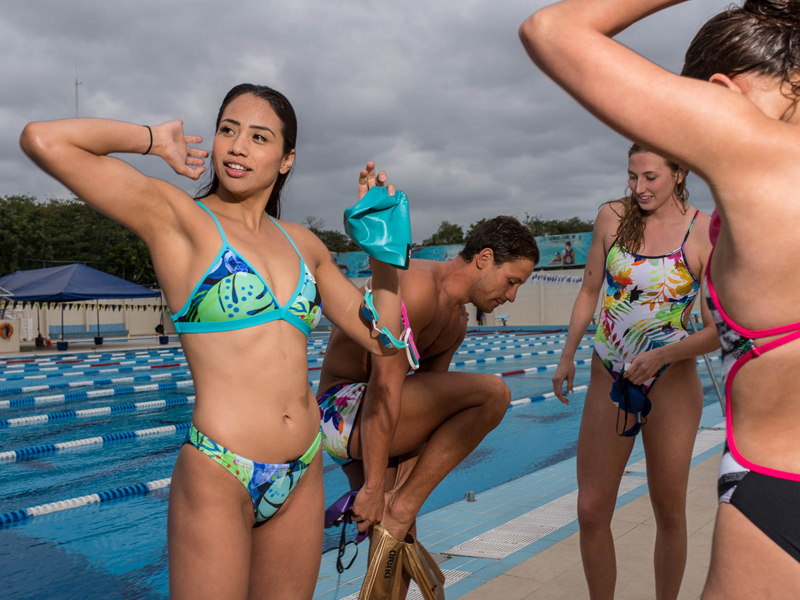Are there different training methods for men and women?
Men and women, explanations for the difference in performance levels
It is never easy to talk about the difference in performance levels between men and women. We might, for example, take a look at the difference in the two world records for the 100 metres freestyle in an Olympic pool, which corresponds to approximately 10%, or, alternatively, work out the average for the world’s all-time top ten performances by men and women.
So why are there such clear-cut differences in swimming performance between men and women?
The answer lies in certain key parameters:
Anthropometry
The first difference between men and women when it comes to swimming can be found in anthropometrics. Women are at a disadvantage compared to men due to both their stature – smaller on average – and also the proportions between the different parts of the body. This means women cannot generate as much power as their male counterparts, so their work output is lower.
On the other hand, though, as women grow they develop a lower centre of gravity, which gives them a better sense of balance and stability, both key factors in keeping the body stable in the water.
Weight and body composition
As we all know, on average women weigh less than men but they are penalised by the difference in body composition: women have approximately 25% body fat compared to 15% for men.
Although the higher percentage of fat has a negative effect on performance in the pool, it does allow women to float more easily. This means they can save energy and keep their legs closer to the surface of the water, resulting in a more hydrodynamic swim stroke.
The cardio-circulatory apparatus
Women’s hearts are smaller than men’s (650 cc compared to 800 cc) and their cardiac output is on average 25% less than men’s. This limits the blood’s oxygen-carrying capacity in the case of women, meaning they are at a disadvantage when it comes to aerobic disciplines in particular.
Maximum oxygen consumption (VO2max)
The VO2max of an adult woman is on average lower than a man’s. One of the reasons for this could be the difference in body composition (notably the fact that women have a higher percentage of body fat), as well as the difference in haemoglobin levels (10-14% higher in men due to higher testosterone levels).

So in light of everything that has been said, the obvious question is: are there different training methods for men and women?
There is no obvious answer to that; although there are certainly different ways and means of improving performance.
At the highest levels, men and women are capable of sustaining similar workloads, but they will never be exactly the same. Differences in physiological traits prevent that and, in actual fact, they indicate that, in the case of women, quality training is more effective than aerobic sessions.
Here are three work-outs of increasing difficulty carefully tailored to quality
Women will, perhaps, find it easier to complete these workouts, due to their superior capacity to handle sessions like these. Try incorporating them at least twice a week in your training plan and see if you notice any benefits.
The following work-outs should only be performed after warming up properly and be followed by a swim-down to lower lactic acid levels.
- Work-out 1 – relatively easy:
6x50m freestyle with 2:30 min rest between intervals. Swim speed = fast and steady. Once you can complete all the intervals at the same speed, trying reducing your rest to 15 sec.
- Work-out 2 – medium
4x50m freestyle with 2 min rest + 2x100m freestyle with 3:30 min rest. Here again try and keep your swim speed high and steady. If you can do this, move on to the next set.
- Work-out 3 – extremely difficult
6x50m freestyle with 2 min rest + 3x100m freestyle with 3:30 min rest. Fast and steady.
Right, we have given you some tips, so don’t you think it is time to try them out now?
In forthcoming articles we will talk about quality swimming and how to develop this extremely important aspect from a performance viewpoint.
Keep on following us!
WHILE YOU WAIT TO GET BACK IN THE POOL…
Articles you may also like…
Butterfly – Training plan for beginners and amateurs
Feel the Power! Discover our new Powerskin Carbon Core FX
Join arena SWIM!
DISCOVER MORE at www.arenaswim.com
Are you looking for the ideal training swimsuit for your own specific needs?
Written by:
arena coaches
Swim coaches, trainers and experts will give you all kinds of tips for performing at your best in both training and races.







